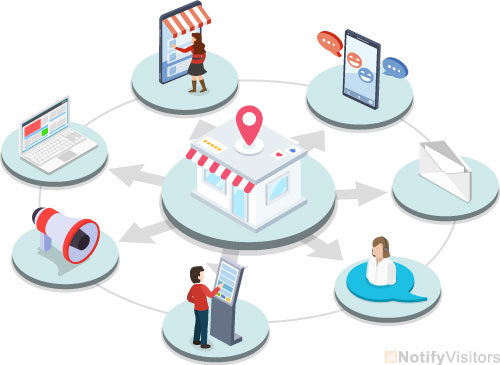It’s no secret that consumers today hold more power than ever before. As a marketer, you’ve got to go where your target audience is and figure out which platforms they’re using at what times.
But, simply sticking to one channel won’t give you a complete picture of your audience. This can make it tough to create a customized, all-encompassing customer experience. That’s where cross-channel marketing comes in. By factoring in every touchpoint, you can make sure that your message is on point at every stage of the consumer’s interaction with your brand.
What is Cross-channel Marketing?
It is a popular digital marketing technique that puts your customers at the center of everything. It helps to create an integrated experience across all digital media and platforms.
This technique is a powerful way of designing your marketing strategy. And using data analysis to create an omnichannel customer journey toward your goals.
If you’re worried about managing multiple channels, implementing cross-channel marketing can seem intimidating. But, it doesn’t have to be!
You just need to keep track of every campaign and integrate their analytics to make the most of this strategy. It can help simplify the process and make it easier for you to achieve your marketing goals.
Also Read: 3 Ways To Seamlessly Align Your Sales & Marketing Teams
Why you should try Cross-channel marketing?

Are you wondering why you should try cross-channel marketing? Well, here are some reasons why it can benefit your business:
Firstly, cross-channel marketing can make the shopping experience more personalized for your customers. By using multiple channels, you can ensure that your brand is always visible and stays on their minds.
Next, it allows you to move your prospects smoothly through the sales funnel across different channels. You can even continue your marketing efforts from where you left off on the first channel.
Here are a few key benefits of cross-channel marketing:
1. Optimize the Customer Journey
To optimize the customer journey, take a holistic view that considers both offline and online channels. Cross-channel campaigns can improve marketing budget efficiencies by 15 to 20 percent. To get a complete view of how customers engage across channels, use unified databases that store customer data in a single, central location.
2. Increased Engagement
Multi-channel customers are very valuable for your business, as they are more likely to make a purchase once a week or more. To increase engagement, put your brand in front of the customer through strategic hashtags and direct response marketing. Anything that encourages people to interact with your brand will help build engagement.
3. Create a Strong Brand to Build Better Relationships
Use multiple channels to create a stronger brand and drive customer loyalty. Maintain a consistent look and message at every touchpoint by sticking to a consistent brand and style guide. Each channel should complement the next, working together to create an immersive brand experience.
In today’s world, there are so many marketing channels to choose from. That’s why having an efficient cross-channel marketing strategy is a must. You want to make sure that your brand is always in front of your target audience, which can increase the chances of converting them.
Also Read: Why T-Shaped Marketers Hold The Key To Success In The New Marketing Age
Tips to create a cross-channel marketing campaign
Here are some tips on how to develop a winning strategy for cross-channel marketing.
Understand your customers with buyer personas:
Before creating your marketing strategy, it’s important to know your customers well. To achieve this, create rich buyer personas that contain information about your customers’ preferences, behaviors, buying habits, and communication preferences. Social listening can help you find out your audience’s needs, desires, and pain points, which are essential for developing buyer personas.
Use mediums that complement one another:
Choose channels for cross-channel marketing that complement each other. Certain channels work better together than others. Incorporate all channels through which your audience interacts the most with your brand. For example, you can ask your customers to check in via your app when they visit your store or include URLs in emails.
Unify your data:
A customer data platform (CDP) is the backbone of a cross-channel marketing strategy. Having all your data within a CDP is essential to capture and analyze your leads’ touchpoints. This involves using browsing cookies or tracking URLs. Establish connections between online actions with an individual lead’s profile. Track and analyze the emails that have been sent to them. Find out which ones they have interacted with, and also know which blog posts they have read. Gather the data about social media campaigns they engaged with.
Align content with a specific buyer’s journey:
Each customer’s journey is different, and each of them should be treated differently. Design content specifically for individuals based on their consumer habits. Your content strategy should align well with all buyers’ journeys. When a customer abandons their cart, you can send out an email that offers a discount to them. Similarly, for those who purchase your products, you can send them a thank you email. This way, they’ll engage with your content on a different channel and take the action you want them to.
Personalization is the key to success:
It can improve your sales as customers are more likely to engage with content that gives personalized recommendations. Nearly 84% of customers said that being treated as a person is crucial for winning their business. Spend time creating buyer personas to understand your customers well. After you can personalize content according to their preferences.
Cross-marketing requires a broader and more holistic view of your marketing needs. It’s a great way to connect with your audience in different ways and increase your chances of success. By following above-given tips, you’ll develop a winning strategy. Good luck with your campaign!
Benefits and Drawbacks of Cross-Channel Marketing:
Though there are numerous benefits of Cross-channel marketing, It’s important to keep in mind that there are both benefits and drawbacks to that approach.
| Benefits of Cross-Channel Marketing | Drawbacks of Cross-Channel Marketing |
| Multiple channels generate more visibility | Complexity of syncing up multiple moving parts and teams |
| Customers have more choices | Requires more time, costs, and effort |
| More touchpoints for data collection | Can’t focus on just one medium |
| Consistency of message strengthens brand | Difficult to prioritize and balance different channels |
Brands Using Cross-Channel Marketing: Success Stories
Let’s take a look at two brands that effectively used cross-channel marketing to achieve success:
1. Mercedes Benz
Mercedes Benz launched its CLA product using a combination of online and offline methods. They utilized their “Generation Benz” online community to understand their audience and tailor their tactics accordingly.
To create buzz, they aired a Superbowl ad featuring Usher and Kate Upton. They also bought Facebook ads, used the hashtag #clatakethewheel. They also partnered with Instagram photographers and YouTube personality Casey Neistat for influencer marketing. Their efforts garnered over 85 million organic impressions and 2 million likes, resulting in a 14% increase in November sales.
2. Starbucks
Starbucks integrated its app with its offline experience, using a reinforcement learning platform to offer personalized recommendations based on customer shopping habits. The app also sends push notifications for sales and promotions, encouraging more foot traffic.
With this approach, Starbucks can effectively reach customers anytime and anywhere. Customers can reload their cards and make purchases directly from their phones in real-time.
In summary, cross-channel marketing can provide valuable insights into customer behavior and improve campaign decisions. Brands like Mercedes Benz and Starbucks have effectively used this strategy to connect with their audience and drive success.
Cross-channel, multichannel, and omnichannel: What are the differences?
If you’ve been listening to cross-channel marketing, you might have also heard about multichannel and omnichannel marketing. Although they’re similar in concept, there are significant differences between them.
Let’s break it down:
1. Multichannel marketing
Multichannel marketing involves using multiple channels (direct or indirect) to reach customers. Direct channels might include in-person or phone sales, emails or texts, online display ads, TV, or radio. Indirect channels might make use of online reviews, news articles, press releases, SEO, referrals, and word of mouth.
2. Cross Channel Marketing
Cross-channel marketing also employs multiple channels to reach customers. The key difference is that these channels are all connected to each other. This makes for a more seamless transition from channel to channel. It records information about the customer and communicates this data to each other.
Also Read:
Also Read: How Creative Subscriptions Are Changing The Marketing Game
3. Omni-channel marketing
Omnichannel marketing takes cross-channel to another level. It involves multiple channels being interconnected as well as interactive. These channels simultaneously exchange information about customers. They come together to create a seamless experience across all channels that allows for maximum engagement.
So, which one should you use? It depends on your resources, needs, and customers. Some businesses choose to connect only their online channels, while others sync up their online and offline channels. These include print, direct mail, billboard advertising, and radio. Ultimately, the choice is yours!
Conclusion
So, we just talked about how a cross-channel marketing strategy can really work wonders for your business. By analyzing the data from your marketing campaigns, you can continually improve your strategy and achieve tangible results.
It’s important to make sure that your content and customer service are consistent across all channels so that your audience has a seamless experience. And don’t forget to test your strategy with control groups and refine it until it’s perfect.
Do you have any other tips or tricks for implementing a successful cross-channel marketing strategy? Share your thoughts in the comments below!
Editor’s Choice:
Crafting With Caution: AI And The Art Of Balanced Content Creation
Branding Limit: Where It Works And Where It Falls Short
Get Ready For Black Friday: 7 Steps By Meta For Your Facebook Ads






